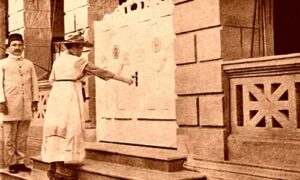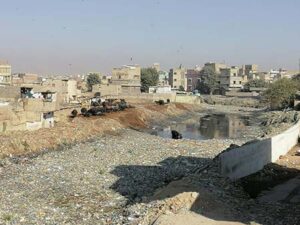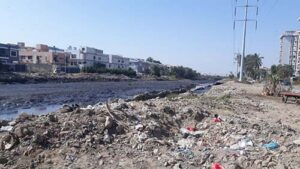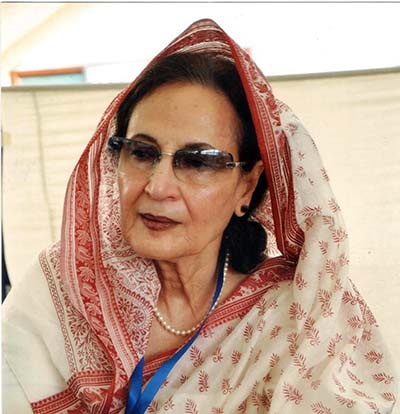I write as a layman, not as an expert, of a city that is very dear to me. I write as a senior citizen who feels a great sense of loss at the abysmal state of this city.
Karachi, whose known history dates book to almost 500 BC, was formally a fishing village named Kolachi by tribesmen from Balochistan in 1720, who were later joined by Sindhi fisherman. It remained a small village even under the Talpur rulers, with the original residents living in mud houses in the two settlements of Lyari and Manora. The keen eye of the British scouts of the British East India Company, forever scavenging for the company’s interests, noticed the potential of this humble village – its strategic location at the mouth of the river Indus, its natural harbour opening out to the Arabian Sea, many water springs, and an ephemeral sweet water river flowing by – and reported this great find to their bosses. After its initial capture by the British East India Company in 1839, Karachi became part of the British Indian Empire in 1843, when General Napier conquered Sindh. The farsighted British started developing Karachi’s deep water harbour, for shipping this produce of the province abroad, a railway and riverine system to facilitate internal transport of people and goods and established a military cantonment to protect this treasure from other rapacious colonial adventurers. With the growing opportunities for lucrative business, the city’s population grew, inviting a fascinating mix of immigrants: Persians, Arabs, Afghans, Gujratis, Marwaris – people of different faiths from not only India, but surrounding countries.

Within a period of 40 years, the town morphed into a city with a large and prosperous population of a hundred thousand, in the 1890s. Despite their exclusive White Policy, the British ensured the housing comforts of the new immigrant merchants in the planning of the prized city and accommodated them according to their service utility, in graded townships. The ones relegated to the shanties of the old city was the labour class of the unfortunate locals – denizens of Lyari, whose lifestyle and environment were unhygienic and squalid. In 1897, the bubonic plague entered and spread in Karachi, resulting in thousands of painful deaths, creating both terror and panic, but this also led to the laying of a strong infrastructure, a complex and sturdy sewerage system, garbage collection and disposal mechanisms, as well as a regular cleaning of the streets and roads of Karachi. To ensure the city’s cleanliness, garbage-littering was a fined offence. The British Government also wisely laid the foundation of a municipal government by establishing a municipal committee, comprising government officials and the city elders.
Karachi had several unelected mayors. However, in 1933 Jamshed Nusserwanji Mehta became its first elected mayor. Annual elections were held under a mayoral system, with rotating candidates from the three major communities of Muslims, Parsis and Hindus, with an occasional Christian community representative. The degree of their commitment to the cities was such that Karachi was described as the ‘Paris of Asia’ till 1947. Most of the city’s monuments and landmarks predate Partition – the impressive colleges, schools, markets, clock towers, the KMC building, hospitals, dispensaries, parks playgrounds, beachfronts, places of worship, and the beautiful residential buildings and offices that come under the present City’s Heritage Act, but which remain unrestored. Once upon a time, Karachi had a proper infrastructure of clean roads, great transport services, adequate water supply, enough to even wash the roads, a well-functioning sewage system, many parks and playgrounds, several recreation spots and the clean water of Lyari river that could safely be used for drinking, and in whose waters, people sailed, swam – and dhobis could give a good wash to the city’s dirty laundry. Sounds like a fairy tale – and it was so. There are still many, especially in the old city, who can testify to this. Karachi was a city owned by all. Life was secure and relationships between the people of several ethnic communities and different faiths were so cordial that Karachi did not suffer the sorrows of Partition.
In 1947, Karachi, the then capital of Sindh province, was selected by the Quaid-e-Azam as the capital of the new sovereign state of Pakistan. To deal with the expected influx of refugees, their housing, and Karachi’s governance and development issues, the Karachi Improvement Trust (KIT) was formed in 1950. The KIT comprised a board of trustees, headed by a chairman appointed by the central government. In 1950, the KDA replaced the KIT as the city’s planning authority.
Karachi, no longer the federal capital, continued to grow and, in the early 60s, it became the economic hub of Pakistan and a role model for the world. It attracted migrants from all over the country. Land, and housing for the new immigrants became serious issues then, and continue to be so to date as the city kept on expanding without any formal planning, and the population increased beyond calculations. Today, out of the approximately 22 million residents of Karachi, more than half live in unplanned townships some regularised over a period of time, others not so to this day. Karachi’s expansion in all directions is phenomenal. Many parts of the city’s coastline have been reclaimed, many of the agricultural suburban farmlands and orchards have given way to elitist residential societies. Who is responsible for this transformation? Almost all the land-owning agencies of Karachi, in collusion with the land mafia.
When we study our political history, we discover that most civilian governments were allergic to the third tier of government. It was a general, General Zia-ul-Haq, who allowed the first mayoral elections to be held in 1979 and Abdul Sattar Afghani became the first elected mayor of Karachi. But the city remained in a state of abysmal neglect and turf wars from 1988 onwards; Karachi was wracked by the violence of brutal mafias, crime sprees and hartals, destroying the productivity of the city’s industry, and the city’s GDP (Gross Domestic Product). The city’s infrastructure was also further degraded. In the year 2000, when Gen Musharraf took over, he decided to revitalise Karachi’s flailing industry and attract internal and external investors by refurbishing Karachi’s dilapidated infrastructure, hoping to make it a world-class city. This meant heavy investment.
In 2001, the Sindh Local Government Ordinance was passed, enacting a new system of local governance with an elected and empowered mayor. Gen Musharraf gave Rs. 29 billion to Mayor Naimatullah Khan in a partnership package, similar to PM Imran Khan’s Karachi Transformation Package of August 2020, to uplift the worn-out city. The reports on this package, Mayor Naimatullah Khan’s presentation, and General Musharraf’s directives make for an interesting read. Its priorities were water supply, a totally overhauled sewerage system with functioning water treatment plants, refurbished roads, transport and a clean-up of the Lyari River, with particular emphasis on refraining from indulging in wastage or over-invoicing. All this was to be accomplished within a period of four years. Anyone of material consequence in the city’s administration plus industrialists of the Site area, and other stakeholders were invited to become members of the team to oversee this uplift.

Whatever improvements were made in the years of the City District Government Karachi (CDGK) came to naught after the 2007 Elections. The entire local bodies system was rolled back and Karachi relapsed into administrative dysfunction. The 18th Amendment, that was a boon for the provinces, proved to be a bane for Karachi’s hope of development as a world class city. It restricted the federal government’s influence, except indirectly, through its land-owning authorities. The mayor’s office and the KMC were reduced to a superfluous body with trivial responsibilities and a huge staff! All its former roles and finances now came under the Sindh government and the federal government could do little about it.

What is visible in the year 2021, to the distress of all, is that Karachi’s infrastructure is in a state of virtual collapse. Almost every day, the print and social media post pictures of garbage heaps, flowing sewerage streams, dangerously potholed roads, long water queues and insanely overcrowded buses. None of the city’s three effluent plants are functioning and the Lyari and Malir river, along with other drains, spew their contents of animal and human excreta plus poisonous industrial and medical waste and garbage remnants into the precious waters of our coastline and harbour, destroying its flora and fauna, contaminating its marine life, which in turn enters our food chain as chicken feed and further adds to our health hazards. The infrastructure of the two major industrial zones, Site Town and Korangi, now compete with the ruins of Mohenjo-Daro. Water supply to the whole city is a sorry tale of lost hours, as women and, children, old and young queue for hours for a few gallons of water, in katchi aabadis, or pay small fortunes for water tankers in the high-end areas of Karachi.
Many survey reports have been written by internal donor partners and our urban planning experts on the need for a Master Plan and the right kind of infrastructure to make Karachi a livable city, but how seriously they are taken is evident from the fact that a Master Plan is still awaited.
Karachi is among the 10 largest cities of the world, and is internationally indexed among its most “unlivable and dirtiest” What’s more, it does not have a local goverment system or elected mayor as all other democratic metropolises of the world, such as Tokyo and New York, do.
Karachi’s governance is, at present, under 20 land-owning authorities and civic utility services departments namely seven DMCs (District Municipal Corporations), and an appointed KMC administrator, six military cantonments plus the federal land-owning authorities of KPT (Karachi Port Trust), CAA (Civil Aviation Authority), Railways and Port Qasim, LDA (Local Development Authority), KDA (Karachi Development Authority) and MDA (Malir Development Authority). It is ridiculous that a city which is the economic backbone of Pakistan, a city that is recognised for its unique geo-political status, whose port not only serves its own landlocked provinces of Punjab, Khyber Pakthunkhwa, Balochistan, but also the entire north and north-western regions that surround it, ‘the Primate City’ of Pakistan, the largest economic center of the country whose port handles approximately 95% foreign trade and whose revenue feeds the entire country, is subjected to such vivisected governance and administrative chaos. The depths of degradation that it has been allowed to sink into is very visible from all its entry points – be it the Karachi International Airport, the Karachi City Railway Station or the Keamari Harbour or the Superhighway.
Take a trip down the Lyari expressway. You will see the dysfunciality of the many authorities that govern Karachi and the habitats of the people bordering its banks living in patches of prosperity or squalor. Is anyone among them interested in owning Karachi? Every year, people’s lives, properties and businesses are lost during the monsoons because Karachi, after 74 years of being the cash cow of Pakistan, still does not have a functioning sanitation and drainage system! And this situation prevails across all zones of Karachi, posh and not so posh, subjecting all citizens to equal desperation. Are they going to queue up to own Karachi? No. They are engaged in fending for themselves.
Adding to Karachi’s woes is the three-year-long confrontation between the federal and provincial governments for Karachi’s control. Recently, at the launch of the Karachi Comprehensive Coastal Zone Development Project the Prime Minister admitted that the federation and the province have to join hands in order to restore Karachi to a state of livability and productivity, while respecting and recognising the status of the provincial govermnent. This is, perhaps, the first true conciliatory approach made by the leader of the PTI Govt.
The Pakistan People Party should reciprocate likewise. At its inception, the PPP emerged as a national force. Over the years, it has been reduced to a regional party. Before suffering more insults from the superior judiciary for its treatment of Karachi, the Sindh government should call for the long-awaited city census and the local bodies elections. It should modify the Sindh Local Government Ordinance (SLGO) 2013, to give comprehensive powers to the local government; an autonomous administratively financially empowered mayor, directly elected by the people, and if he fails in his responsibilities, he should be voted out by them. This will be set the course for Karachi’s revival. It will also transform the current image of the PPP from a regional party to a national one.
Karachiities feel betrayed that their welfare is not a priority with either the centre or the province. An enduring rapprochement between the federal and provincial governments would go along way towards bridging the huge trust deficit in the citizens, against both. If the faultlines of the Karachi Transformation Plan (KTP), are corrected, a functioning PCIC (Provincial Coordination and Implementation Committee) working on the 1950 Karachi Improvement Trust model, giving citizens the utilities they yearn for, a major change can take effect. Karachities are among the most dynamic, intelligent and entrepreneurial people in the world. If the necessary conducive environment is provided to them, they will become the government’s best partners in restoring Karachi to its former status as a world class megapolis – the pride of Pakistan. Karachi will then be Hum Sab Ka Karachi.

The writer is convener of Karachi Citizens’ Forum, which regularly highlights the mega-problems of the megacity. She is also the Chairperson of Pakistan Women’s Foundation for Peace.

